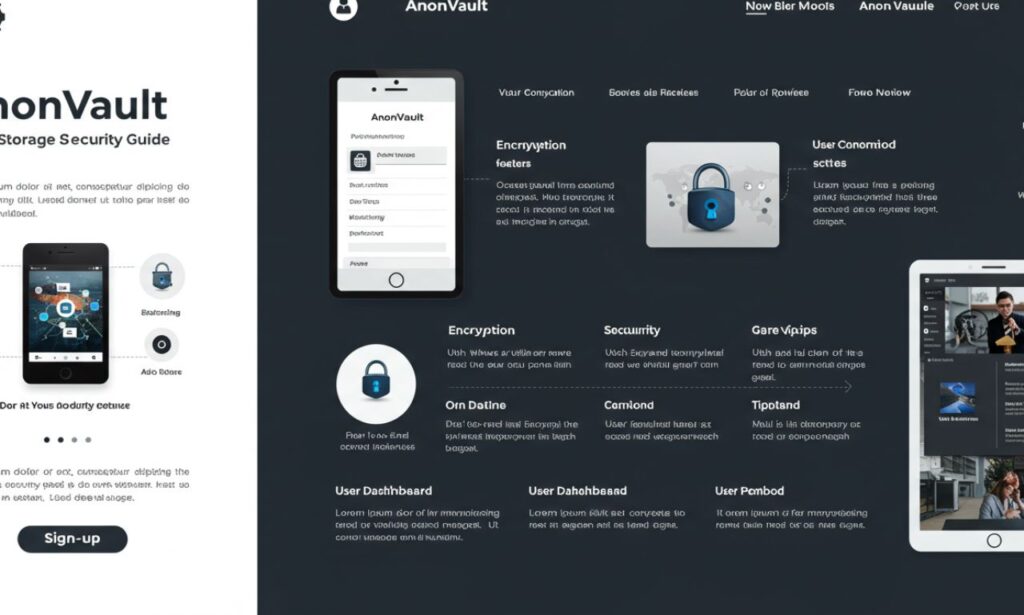AnonVault (often written “Anon Vault”) is a privacy-focused digital storage service designed to help individuals and organizations store, share, and manage files with strong security and minimal traceability. The hidden aim is to minimize identity exposure and metadata leakage, while keeping data encrypted and under your control.
AnonVault isn’t just a cloud drive — it’s built around features such as end-to-end encryption, anonymous access, possibly decentralized storage or blockchain components, and tools for sharing files without requiring typical identity markers like email or full name.
Key Features of AnonVault
Encryption & Zero-Knowledge Architecture
-
Files are encrypted on your device before upload, meaning only you (or people you authorize) hold the decryption keys. Anyone else, even the service provider, cannot read content.
-
Zero-knowledge design, that is, the system has no ability to access or decrypt your content without the keys.
Anonymity & Identity Minimization
-
No need for traditional identity verification (e.g. full name, phone, or sometimes even email) for some versions, depending on implementation.
-
Minimization of metadata: upload times, IP logs, device identifiers may be stripped or not stored, again depending on variant.
Secure File Sharing & Controlled Access
-
Ability to share files via secure, time-limited or revocable links. Recipients may need keys or passwords to open.
-
Access control features: who can open, download, or view files; possibly logs for those access events.
Cross-Platform & Decentralization Options
-
Works via web browsers, possibly mobile devices; goal is to make storage accessible across devices without sacrificing privacy.
-
Some services similar to AnonVault use decentralized networks (Tor, IPFS) or blockchain infrastructure to avoid single point failures or control.
Additional Security Measures
-
Multi-factor authentication (MFA) or similar extra layers.
-
Regular security audits / updates.
Advantages of Using AnonVault
-
Strong privacy: Your identity and digital footprint stay limited; risk of profiling or tracking is reduced.
-
Data protection: Even if servers are compromised, encrypted files without keys are practically useless to attackers.
-
Control of sharing: You choose how long links live, who can access, and who holds keys.
-
Suitable for sensitive use cases: Journalists, activists, researchers, or anyone needing to store private documents safely.
-
Potential resilience: With decentralized options, less risk of service shutdowns or censorship.
Limitations & Risks
-
Loss of key is loss of data: Since many versions give only you control of decryption keys, if you lose the key/password/seed, recovery is impossible.
-
Learning curve: Users unfamiliar with encryption, privacy technology, or decentralized systems may find setup or safe usage nontrivial.
-
Performance trade-offs: Encrypted upload/download, decentralized storage, or routing through Tor can slow speeds and increase latency.
-
Legal / jurisdictional risk: Depending on your country, even anonymous storage may be under surveillance laws, or subject to legal orders. Also, hosting or using anonymous services may be restricted.
-
Free vs paid limitations: Often free tiers restrict storage, retention time, features, bandwidth; premium or paid plans may be required for full feature set.
How AnonVault Works: Setup & Practical Use
Step-by-Step Setup
-
Visit official website or app — ensure the source is legitimate and secure.
-
(Optional) Create an account or vault — if required, but many versions try to avoid collecting identity data. A pseudonymous identifier or key pair might suffice.
-
Generate encryption keys / set password — this is your private key or passphrase; secure backups are critical.
-
Upload files — usually via drag-and-drop or file selection. Files are encrypted locally before upload.
-
Set sharing options — if you wish to share, choose link expiry, password protection, or recipient key control.
Best Practices for Safe Usage
-
Always store keys or passphrases in secure backups, not just on one device.
-
Use strong passwords or passphrases; longer and more random is better.
-
Use MFA if available.
-
Regularly update the software/app to counter vulnerabilities.
-
Limit sensitive data stored; delete files when not needed.
-
If sharing links, restrict them (time, downloads) and consider revocation ability.
Who Should Use AnonVault?
-
Privacy-conscious individuals who want to keep files like identity documents, finances, or personal diaries stored without easy trace.
-
Whistleblowers, journalists, researchers who need secure channels to store and share sensitive materials.
-
Businesses handling confidential data that want to minimize risk from insider leaks or cybercrime.
-
Users in restrictive environments keen to avoid surveillance or censorship.
What to Verify Before You Rely on AnonVault
-
Read the security documentation: which encryption algorithms, threat model, key management, audit reports.
-
Confirm no metadata logging: see if the service claims zero IP logs, no device identifiers, etc.
-
Test the sharing features: link expiry, password protection, revoke access.
-
Understand data jurisdiction: where the servers are located, what local laws might apply.
-
Check free vs paid limitations, and costs vs storage, bandwidth, retention.
-
See whether key recovery is possible or not, and what happens if you lose your key.
Real-World Use Cases & Scenarios
-
A photojournalist working on sensitive stories wants to store source material in a vault that can’t be accessed by intermediaries — uses AnonVault to encrypt and share only with trusted contacts.
-
A legal consultant needs to send contracts to clients overseas without exposing metadata or leaving a trail — uses expiring link sharing with password protection.
-
A health researcher stores personal data or patient files with high privacy requirements, so uses zero-knowledge architecture to mitigate risk of data leak.
-
A user simply wants a place to backup their identity documents and personal files, preferring not to leave them on big cloud services with complex privacy policies.
Future Directions & What’s Possible
AnonVault (or services like it) may evolve in these ways:
-
Better cross-platform UX: making key management, sharing, revocation, backup simpler for non-technical users.
-
Stronger decentralized infrastructure: more use of IPFS, decentralized nodes, blockchain for transparency.
-
Private AI features: e.g., scanning for threats or malware without exposing file contents.
-
Standardization of privacy proofs: publishing audits, proofs of no logs, open source code.
-
Interoperability: allowing vaults across providers to share or sync securely.
Verdict: Is AnonVault Right for You?
If you highly value privacy, control over your data, and want to avoid services that collect personal info or log metadata, AnonVault offers a compelling option. Its strengths lie in encryption, anonymity, and strong user control of sharing and keys.
However, if you prioritize convenience above all else, or need easy account recovery, or are handling large volumes of data under tight deadlines, the trade-offs in speed, possibly complexity, or risk of losing keys might make more user-friendly but less private services more suitable.
Conclusion
AnonVault (Anon Vault) positions itself as a robust, privacy-first digital storage solution. It aims to minimize identity exposure, ensure robust encryption, and grant users control over what gets shared, how, and with whom.
Security features like zero-knowledge encryption, optional link expiry, and minimal metadata collection are its big selling points. But with those come responsibilities: safe handling of keys, understanding trade-offs of speed vs privacy, knowing legal and jurisdictional constraints.







